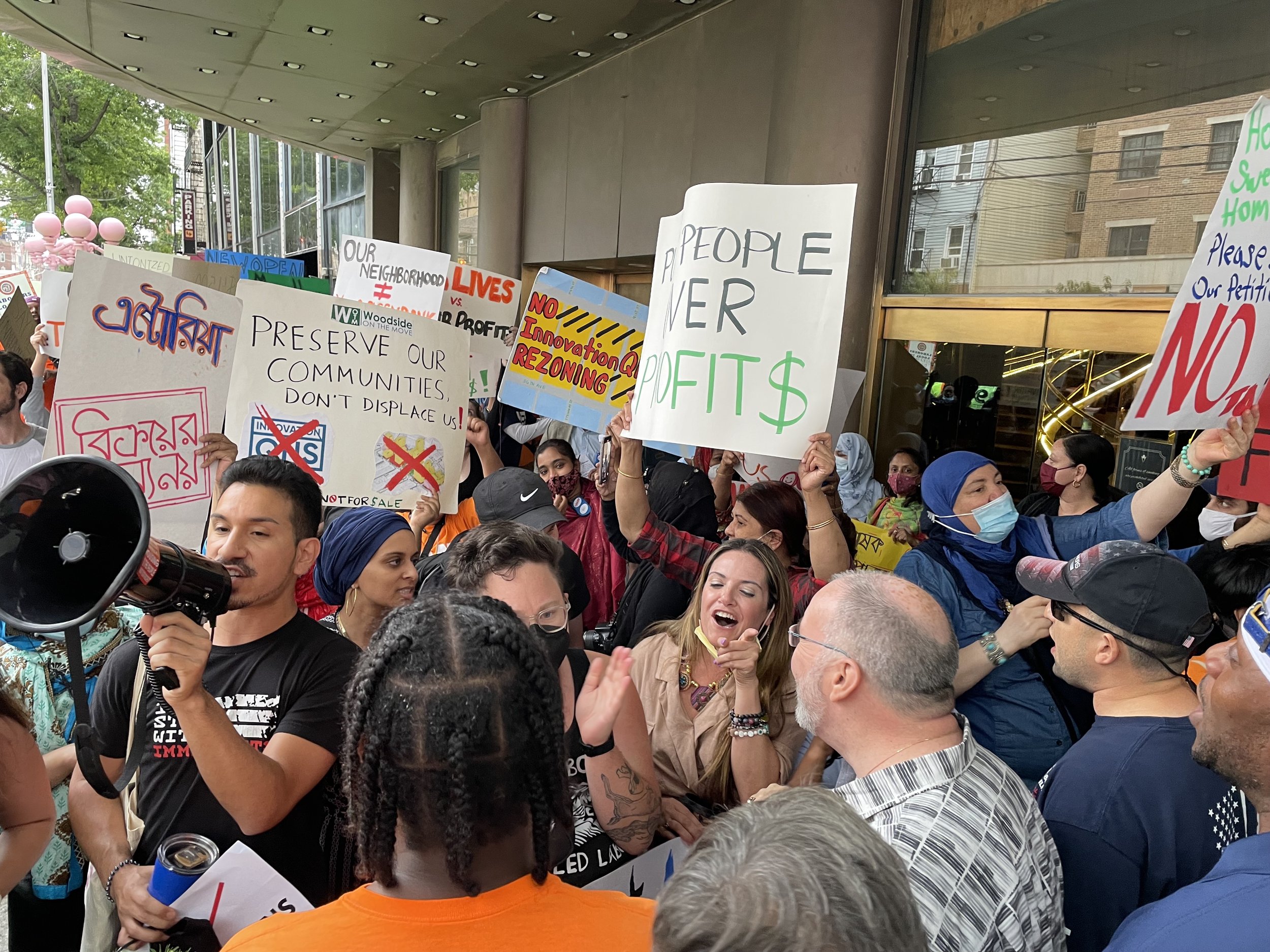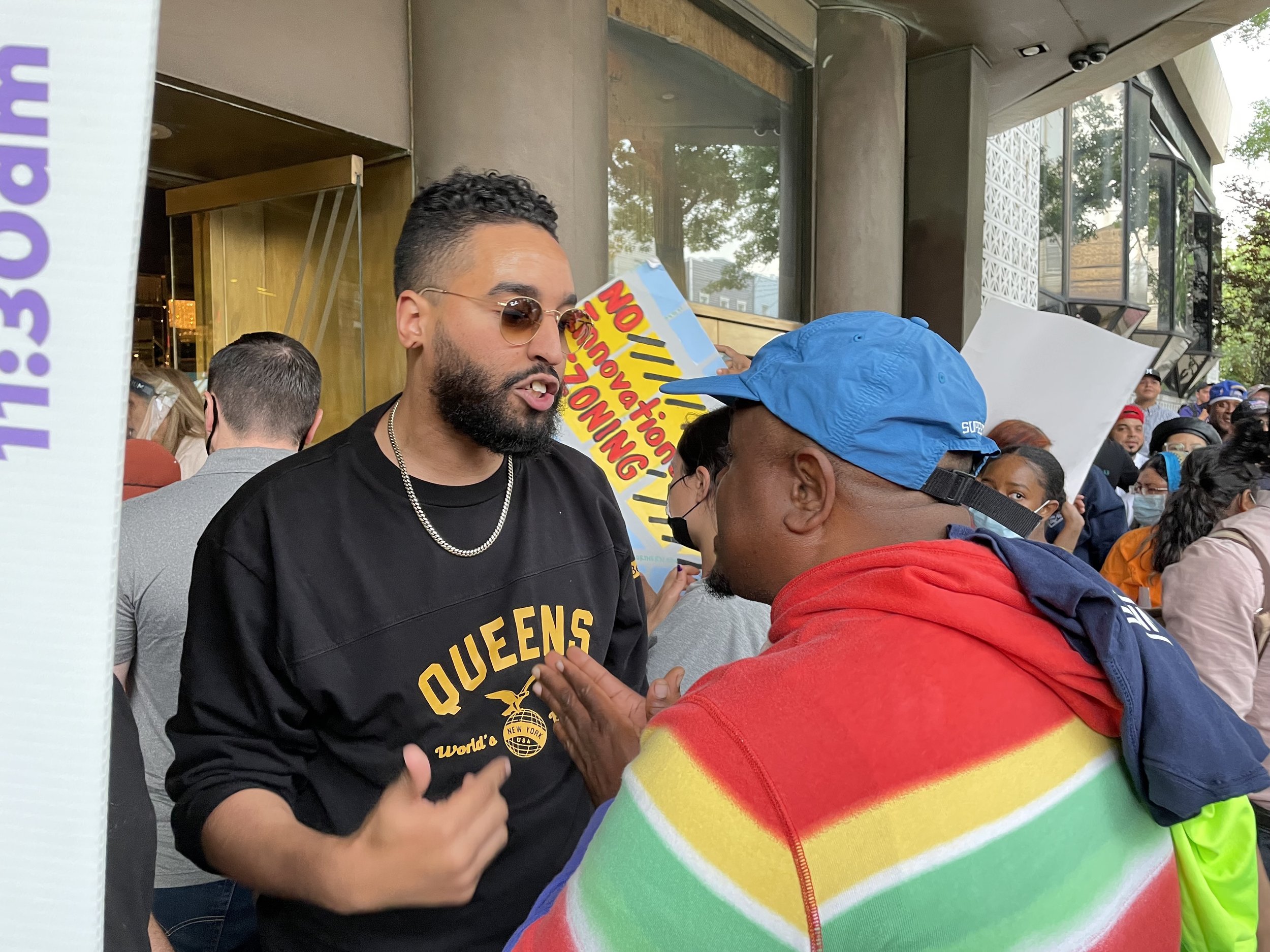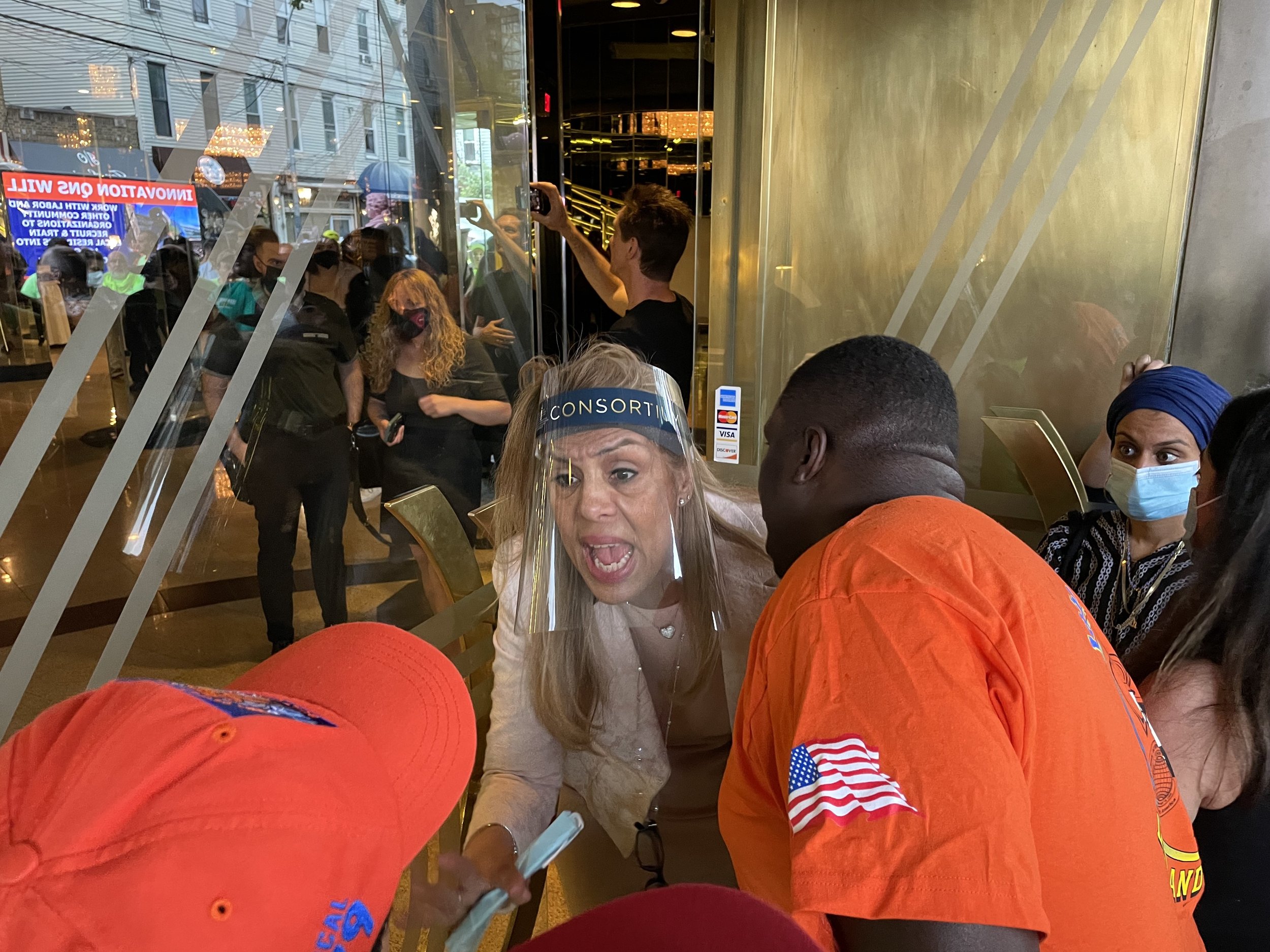In-NO-vation QNS: Massive development in Astoria voted down by local community board
/Innovation QNS supporters and opponents clashed prior to Community Board 1’s vote on the five-block development slated for Astoria. The board voted against the project on Tuesday, June 22, 2022. Eagle photo by Jacob Kaye
By Jacob Kaye
Five hours before Queens Community Board 1 would eventually vote down one of the largest proposed developments seen in the borough in decades, it was unclear whether the night would end without serious conflict.
A group of about 100 local residents and community organizers and another group of about 100 union workers staged opposing protests against and in support of Innovation QNS, a massive, five-block development planned for Astoria, outside of Astoria World Manor where the board met on Tuesday night.
A megaphone on each side, the groups chanted without clashing for about a half an hour. That’s when about 10 union workers made their way to the other side of the community group, sandwiching them between two clusters of supporters of the project.
The chants grew louder as the two sides screamed their positions inches away from each other’s faces. At one point, the driver of a truck with an LED sign showing an advertisement in support of the project began blasting music from the parked vehicle in an apparent effort to drown out the “Astoria is not for sale” chants.





Though the tensest moments of the evening would eventually die down without serious incident, the line in the sand had been drawn deeper than it ever had been in the nearly four years since the project’s developers first began meeting with the board that would eventually vote them down 24 to 8, with 4 abstentions.
Innovation QNS, a $2 billion development that would stretch from 37th Street to Northern Boulevard and from 35th to 36th Avenue, has been steeped in contention since 2019, when developers Silverstein Properties, BedRock and Kaufman Astoria Studios first began formally pitching the project.
The project, if it’s eventually built, would redesign an entire neighborhood, which is currently occupied by a number of warehouses, retail space, six apartments, a P. C. Richard & Son and a movie theater.
Current proposals for the development would see over a dozen new buildings brought to the area, including several reaching 27 stories high. The new neighborhood would include retail space, facilities for local community groups, a renovated movie theater, several open spaces and a food hall curated by a local food guide.
A rendering of a plaza on 38th Street to be built as part of Innovation QNS. Rendering via Innovation QNS
But at the center of the fight is housing.
Developers have proposed building 2,800 apartment units, bringing in around 7,000 new residents. They’ve committed to making 700 of those units, or 25 percent, permanently affordable – the affordable units would be split between affordable senior housing and housing for low income residents. Around 300 of the affordable units would go for less than $1,000 per month.
A report from the community board’s Housing Committee, led by board member Evie Hantzopoulos, found that Queensbridge and Ravenswood Houses residents earning at or below area median income for their neighborhoods would be unable to afford even the cheapest of the affordable units planned for the development.
“On average, zero of the [Mandatory Inclusionary Housing] units would be accessible to residents living in Queensbridge Houses, Ravenswood Houses, or the Ravenswood/Dutch Kills area, and residents would exceed the 30 [percent] rent burden threshold due to income levels for the starting rents,” the report reads.
Queens Community Board 1 member Evie Hantzopoulos rallied with residents against the project prior to the start of Tuesday’s meeting. Eagle photo by Jacob Kaye
A plurality of the units would be one-bedroom units – 40 percent. Twenty percent of the units would be studios, 30 percent would be two-bedrooms and 10 percent would be three-bedroom units.
Those in support of the project say any commitment to affordable housing, especially if exclusively funded by private money, is a welcomed and necessary addition to an area with one of the lowest vacancy rates in the city.
“We need to embrace change and figure out what it is and try to come to a place where we can get something good for us,” said Carl Austin, a Queensbridge Houses resident. “We know we need housing, we know we need jobs. What are we doing? Let's get together and make this thing happen.”
John Tritt, the deputy political director with 32BJ SEIU, said that while he understands where those opposed to the project are coming from, his union sees the project as a good way to create union jobs and housing his members can afford.
“We certainly understand and are sympathetic to the voices of folks in the community who are critical of not just this project, but other projects,” Tritt told the Eagle. “[But] we think that housing needs to be created, there needs to be a whole spectrum of housing.”
“We know that with the addition of market rate housing, there needs to be affordable housing but there needs to be a spectrum of availability that's proposed, and we think this project does that,” he added.
Innovation QNS’ commitment to using union labor on the estimated 10-year construction of the development is unclear. A spokesperson for Innovation QNS did not respond to request for comment on the commitment before press time.
A number of local labor union members rallied and spoke in support of Innovation QNS on Tuesday, June 21, 2022. Eagle photo by Jacob Kaye
But those opposed have questioned the development team’s commitment to building the affordable units.
Community Board 1’s Land Use Committee, which voted against the project earlier this month, has repeatedly asked that the developers increase the number of affordable units. The request has largely been ignored – other concessions, including reducing the heights of several buildings and creating an indoor recreational area have been made in recent weeks.
Though the developers have promised to work with the city’s Department of Housing Preservation and Development to find ways to build more affordable units, they wouldn’t commit to a specific number on Tuesday or in any meeting prior.
“Two things have been going up in Astoria – the rent and luxury buildings,” said Dannelly Rodriguez, an attorney and life-long Astoria resident. “This is a luxury project that is tasked to do the same thing that has been done to me and my family, displace us from our home time and time again.”
The community board heard from nearly 100 speakers Tuesday night. Those in support mostly came from three camps – unions, including DC9, 32BJ SEIU and Laborers Local 79, the local business community and residents of the Queensbridge Houses, where Innovation QNS has canvassed for support. Those speaking against were mostly local residents and organizers with Astoria Not For Sale, a coalition of nonprofits like CAAAV, Woodside on the Move, Astoria Tenant Union and Justice for All Coalition.
Following around two hours of public testimony – which was preceded by hours of public testimony a month before – the board began its deliberations on the project.
Elizabeth Erion, the co-chair of the board’s Land Use Committee, told the full board why her committee voted against approving the project.
“This is unprecedented in this community district and we as a board over the years have supported large-scale developments, as long as the development is appropriate, it is contextual and it isn’t overbearing to the local community,” Erion said.
She said that worries about the potential impact on rents in the surrounding neighborhood, the increased competition for businesses on Steinway Street, the shadows created by the large buildings and the influx of residents moving into the development were too much to look past.
“It’s really an inappropriate development for the community,” she said.
Queens Community Board 1 votes against Innovation QNS from Astoria World Manor on Tuesday, June 21, 2022. Eagle photo by Jacob Kaye
New board member Brian Romero, who also serves as Queens Assemblymember Jessica Gonzalez-Rojas’ chief of staff, was the first to introduce the motion to disapprove the project.
“I just felt it was the wrong thing to do at this time,” Romero told the Eagle on Wednesday. “As someone who has been displaced myself in Queens…I know that pain and what it means being split from your family and trying to figure out how to be stabilized again.”
“From the onset, we were very clear that we are in the midst of a housing crisis…and they continued to come back and make excuses for not doing this,” he added. “We need more affordable housing and 25 percent is the bare legal requirement. We just thought that was not enough and a disservice to a lot of New Yorkers.”
Romero said that he hopes the board’s advisory vote is considered seriously by the Queens borough president, City Planning Commission and the local City Councilmember, Julie Won, who will all issue votes – some advisory, some binding – on the project in the coming months.
“There will be ongoing development that will be proposed and I hope this sets a precedent to build more affordable housing at 50 percent, 75 percent,” Romero said.
A spokesperson for Innovation QNS touted the developer’s commitment to responding to concerns from local residents and the board.
“The city’s formal review process is designed to gather input from the public, and we’re glad to receive that input even as we continue to make the case that New York City – perhaps now more than ever – needs this $2 billion private investment that will create urgently needed mixed-income homes and 5,400 jobs, while generating hundreds of millions of dollars to support infrastructure, public safety, and education,” the spokesperson said.
Innovation QNS will now move to the next level of the city’s Uniform Land Use Review Procedure.
Queens Borough President Donovan Richards will hear a presentation on the project on Thursday, June 30 at 9:30 a.m., via Zoom. He has 30 days from Tuesday, June 21, to issue his advisory opinion on the project.
The developers will then take their pitch to the City Planning Commission, which will have 60 days to hold a public hearing and issue a vote on the application.
At that point, it will move to the City Council and the mayor for a vote.
Won has been critical of the project, though she’s almost exclusively taken issue with what she says was a lack of outreach about the development to nearby residents. She has yet to comment publicly about the merits of the project.
Her predecessor in the council, Jimmy Van Bramer, called the project “wildly out of character to the surrounding neighborhood” not long after it was first introduced.
Won’s office declined to provide comment for this story.
Regardless of where Won lands, her opinion will likely have outsized influence on the vote of her colleagues. Though it was challenged last year, councilmember deference has historically been respected in the legislative body.








